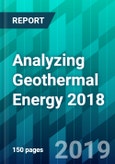In 2017 alone, the global geothermal power generation was over 84 TWh, with cumulative geothermal power generation capacity reaching 14 GW. Keeping with the forecast of moderate growth for the global geothermal industry, global geothermal power capacity is expected to reach 17GW by the end of 2023. It is expected that the capacity additions to the global geothermal industry will be led by Kenya, the Philippines, Turkey, and Indonesia.
As of today, there are only a limited number of countries that use geothermal power for heat production. In 2017, it was only Turkey and China that accounted for almost 80 percent of geothermal consumption. This underperformance of the geothermal industry is attributed to the fact that there are very limited geothermal power resources and these are further limited only to specific areas across the world, particularly the tectonically active regions.
The Geysers in the US is the world’s largest dry steam field situated about 90 miles (145 km) north of San Francisco. The field began production in 1960 which has 1360 MW of installed capacity and produces about 1000 MW net. Nineteen of the 21 plants in the facility are owned by The Calpine Corporation making it the largest producer of renewable geothermal energy in the US. The other two plants are owned jointly by the Northern California Power Agency and Santa Clara Electric.
A unique system of cooperative operation has been devised in between these plants in order to maintain mutual sustenance in order not to overdraw the resource lest it peters off before capacity. Another innovation implemented at the Geysers is the usage of sewage water from City of Santa Rosa & Lake County to recharge the water pits in order to generate steam instead of allowing the sewage discharge into the rivers; thereby achieving double the environmental benefit with one single stroke. The presence of Cal Energy in South Central California through ownership of half of the 15 plants operational there produces a combined of 570 MW of electricity.
This report, Analyzing Geothermal Energy 2018, is a comprehensive guide to understanding geothermal energy and its impact on the economy and environment. The role of geothermal energy is explained with the historical perspective and basics of the generation of geothermal energy from the Earth’s core. The importance of finding the right reservoir before production decision in order to determine that the reservoir will sustain its economic and societal purpose for a projected number of years is also explained in this report in details.
Some of the applications of geothermal energy have been provided in this report chiefly being the generation of electricity and the type of plants implemented to do the same. Heat as a source has many usages in a social context as well and the report explores some of the options used in our daily lives with success and the commendable effort by a hotel in the US to implement the world’s largest geothermal pump application. The report stresses the need for extraction of geothermal energy economically and efficiently as well as managing the carbon emissions from geothermal plants in the US. The WGA estimate of geothermal reserves in the US is provided in the report thereby providing an insight on the potential for geothermal power production in the US.
The role of technology and the interplay of economics with constraints are also delved in to in this report. The role of the US Department of Energy to integrate a nationwide initiative is observed in conjunction with the environmental benefits that geothermal energy has offered to the US which have warranted the department to run some geothermal programs are also provided.
The issue of geothermal energy being able to sustain itself as a long term energy source and the corrective measures necessary in order to recharge the source pits is explained in this report wherein the correct production levels necessary to ensure sustainability are also provided for.
The report further explores the application of geothermal energy in the societal context wherein geothermal energy is helping add positive figures to bottom lines and proving an easy, safe alternative to using fossil fuels continuously. The R&D initiatives undertaken under the aegis of the government and other agencies in order for exploration as well as the future for geothermal energy such initiatives are constructing.
Some of the major geothermal energy projects implemented are profiled in this report along with the major industry contributors are also provided in detail in this report in order to understand the scope of industry interest in this technology which is promising to substitute energy feeder requirements for the future generations.
Table of Contents
A. Executive Summary
Companies Mentioned
- ALRESO Energy Solution
- Alterra Power Corporation
- Berkshire Hathaway Inc.
- Caithness Energy
- Calpine Corporation
- Chevron Corporation
- Enel Green Power
- Energeotek AB
- Exorka GmbH
- Fluor Corporation
- INTEC GMK GmbH
- Northern California Power Agency
- NV Energy
- Ormat International, Inc.
- US Geothermal Inc.








